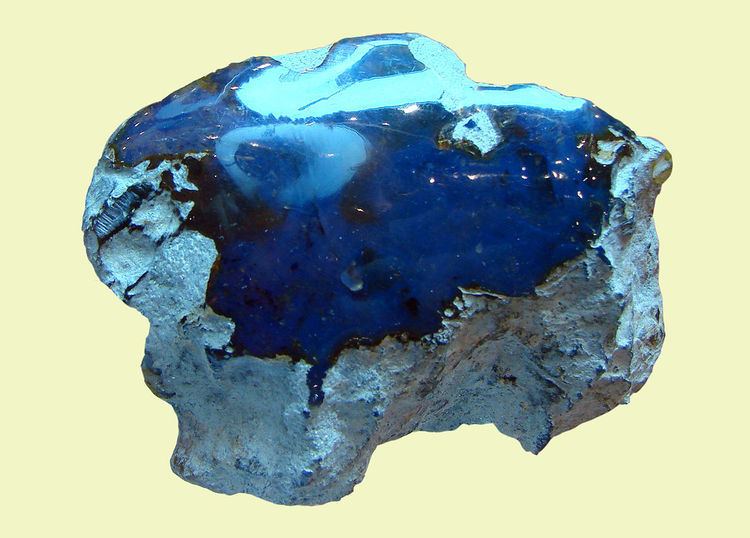 | ||
Blue amber is amber exhibiting a rare coloration. It is most commonly found in the amber mines in the mountain ranges around Santiago, Dominican Republic, but also in the eastern parts of the Dominican Republic. Although little known due to its rarity, it has been around since the discovery of Dominican amber.
Contents
Causes of coloration
When natural light strikes blue amber on a white surface, the light passes right through, and is refracted by the white surface. The result is the slight blue hue of blue amber. When the same natural light strikes the amber on a black surface, the light is not refracted by the black surface, but by the actual amber. Hydrocarbons in the blue amber shift the sun's ultraviolet light down in frequency, resulting in the glow of blue amber.
This effect is only possible in some specimens of Dominican amber category, in some Mexican ambers from Chiapas and some ambers from Indonesia. Any other amber (such as Baltic amber) will not display this phenomenon, because its original resin is not from the Hymenaea protera tree.
The polycyclic aromatic hydrocarbons, produced through a pyrolytic process that is initiated via irradiation, relax to their ground state, absorb high-energy ultraviolet photons and re-emit them as lower-energy visible photons, according to the absorbance curve of the particular fluorophore.
Recently, optical absorption, fluorescence and time-resolved fluorescence measurements in Dominican ambers have been reported. These studies show that the "blue" variety reveals an intense fluorescence emission in the visible wavelength region, between 430 and 530 nm, with spectral features typical of aromatic hydrocarbons. On the contrary, the Dominican "red" and "yellow" amber varieties have a much weaker and featureless emission, although still do have a certain fluorescence. The process in blue amber is surprisingly similar to phosphor.
Although there are several theories about the origin of Dominican blue amber, there is a great probability that it owes its existence to ingredients such as anthracene as a result of 'incomplete combustion' due to forest fires among the extinct species Hymenaea protera trees about 25 to 40 million years ago.
Vittorio Bellani and Enrico Giulotto at the University of Pavia, Italy studied several amber specimens by means of optical absorption, fluorescence spectroscopy, and time-resolved fluorescence measurements. The resulting spectral analysis revealed that the spectra of the hydrocarbons are very similar in shape to those of diluted solutions of anthracene, perylene, and tetracene, and suggest that the fluorescent hydrocarbon responsible for the blueness is most likely perylene.
Appearance
Under artificial light, the amber appears like ordinary amber, but under sunlight it has an intense fluorescent blue glow. When held against the sun it will appear like ordinary amber, and under ultraviolet light it will glow a bright milky-blue.
Blue amber emits a very agreeable smell (aromatic molecules), which is different from regular amber when it is being cut and polished.
